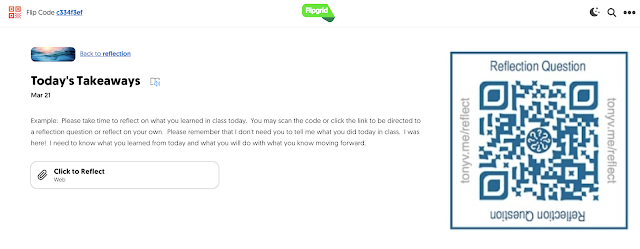I was super stoked to hear that Flipgrid has made augmented reality available on their platform! Yes, you heard me correctly...FlipgridAR is a thing and I can't stop thinking of ways that this will enhance the learning experience for so many students!
In order to use FlipgridAR, you just need to make sure that you have updated the app and that you are using a device that supports augmented reality.
I'm sure that you can think of so many ways that this can work in your classroom but just in case you need a few ideas to get started, here ya go...
1. Home Connections - Attaching a Flipgrid video to an assignment gives you, as an educator, a way to attach personal messages, instructions, or information to things that are sent home. Create a grid or topic just for you to record videos for home. You might include an instruction video so parents will know how to help with homework, a sweet message for the parents of a student that made a good choice, or details about an upcoming field trip. Recording a video gives you a chance to personalize your message and share details in an innovative way that will build relationships between the classroom and home.
2. Genius Hour Pitches - I often suggest that teachers allow students to pitch their Genius Hour projects on Flipgrid so that they can receive feedback from those that see the videos. With FlipgridAR, you could create a space and have students place the QR code to their pitch on this wall or bulletin board. When students have extra time, they can scan and view each other's pitches and consider giving feedback. I'm a baseball fan so I like the idea of calling this The Bullpen because this is where pitches are thrown (see what I did there?).
3. Book Reviews - Knowing what a peer thinks about a book is sometimes enough to cause a student to want to check it out. I know that I enjoy watching Netflix after I've heard someone talk about a specific movie or series. There's just something about watching something that we can talk about later or maybe I just like being "in the know". Either way, kids are no different. Attaching a Flipgrid QR code to the front of a book and allowing students to scan that QR code and use augmented reality to view the video of their peer's review is a great way to make this happen in the classroom.
4. Kindness Counts - I think it's so important to make kindness and empathy a priority in the classroom. Our learners need opportunities to be intentionally kind and empathetic toward others and the classroom is the perfect place to make this happen. Create a Kindness Counts grid on Flipgrid and allow students to hop on when they have something nice to say about a peer or another teacher. After recording their video, they can print out the QR code and place it somewhere specific or just somewhere that it will be seen. I would be willing to bet that seeing a video with a kind message will bring a smile to anyone's face!
5. Give Directions or Modify Work - I had several students in my classroom that needed to hear the directions read aloud several times or needed the directions broken down in order to understand what they needed to do. I also had learners that needed their tests or assignments read aloud as part of the modifications that were to be provided in the classroom. For some, this was not something that they enjoyed because it embarrassing for them to ask for something to be read again or for directions to be repeated. As an educator, you can simply create a video or several videos of the directions broken into smaller pieces and use the QR code to attach those videos to the work. When students need to hear the directions again, they can use headphones to watch the video rather than asking over and over again for things to be repeated. The same can be true for things that need to be read aloud. Create the video reading the selection or material and attach the QR code to the printed version. The learner can scan the QR code to hear you read along with headphones making it more discreet and less of a distraction for others that are in the room.
* Be sure to find out if this is an option as far as modifications go. Sometimes, you must do in the classroom what is going to be done on the day of standardized testing. This is simply an idea for those that are able to make this work in their particular situation.
I hope that this is helpful and I hope you are as excited about FlipgridAR as I am. This is a gamechanger and has the potential to make learning even more meaningful for today's learners. Check it out and feel free to comment below with the creative ways that you are using FlipgridAR in your classroom.
You can subscribe to my email list at www.andimcnair.com.






